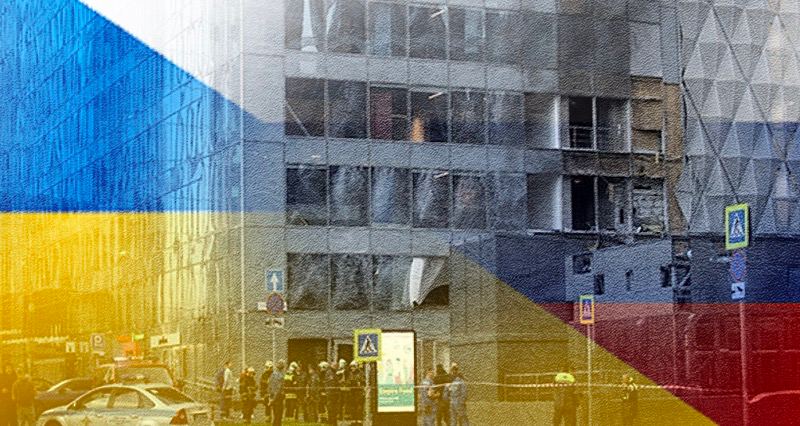In September, Ukrainian drone attacks on Moscow and the Moscow region intensified. On the night of September 1, the Russian Defense Ministry reported the “destruction and interception” of 158 drones, most of which were aimed at targets in the Kursk and Bryansk regions, but some UAVs hit Moscow. One of the drones hit the Moscow Oil Refinery in Kapotnya, and several more attacked the Konakovskaya and Kashirskaya State District Power Plants.
The attacks repeated several nights after September 1. On September 10, UAV strikes severely damaged two apartment buildings in the Moscow region town of Ramenskoye, injuring eight people and killing one 46-year-old woman. Russian media assess these attacks as some of the most violent since the beginning of the Russian-Ukrainian conflict on February 24, 2022. In addition to Moscow and the Moscow region, as well as the Bryansk and Kursk regions, drones were neutralized in the Belgorod, Voronezh, Kaluga, Lipetsk, Oryol and Tula regions.
Escalating tension
While UAV strikes are expected every day in the frontline regions of Russia, and missile alerts have become almost a routine occurrence for their residents, damage from drones in Moscow and the Moscow region was extremely rare until recently. The first attempt to attack Moscow with drones was made in May 2023, when one of them reached the Kremlin and even damaged one of the roofs. Until September of this year, no serious damage – including fatal outcome – was recorded in the Moscow region.
The death and injury of people in a city near Moscow could become a serious precedent for escalating tensions. After the Ukrainian Armed Forces entered the Kursk region in early August 2024, Ukrainian drones began flying further into Russia. If previously regions such as the Lipetsk, Oryol, Kaluga and Tula were relatively safe, now they are expecting arrivals there every day. Although none of these areas have suffered from missile strikes yet, bomb shelters have already been set up in advance in the city centers.
The drone attacks could be further aggravated by the fact that the United States may allow Kyiv to strike Russia with long-range ATACMS missiles. The other day, the press secretary of the Russian president Dmitry Peskov said that most likely these decisions have already been made, and currently an “information campaign to formalize the decision already made” is being conducted in the Western media.
However, the announcement of this decision is still expected from the American establishment. US Secretary of State Blinken, during a joint press conference in London with British Foreign Secretary David Lammy, said that he expects Biden and Starmer to discuss this issue during their meeting on Friday. However, there is really no point in waiting for any official statement. The Ukrainian Armed Forces have been striking Russian territory with American — and many other — weapons at every convenient opportunity for almost three years now.
The official position of the Pentagon today: Kyiv should prioritize the use of Western weapons to protect the eastern and northern regions of Ukraine, maintain access to the Black Sea, and put pressure on Crimea. Following this ideology, the West can justify any actions by the Ukrainian Armed Forces against Russia, as they have already justified the invasion of the Kursk region. Moreover, the American embassy in Moscow told Russian media that Washington will not take responsibility for Kyiv’s actions. Such a statement can be interpreted as a complete carte blanche for the Kyiv regime in response to the fact that Ukraine will not carry out its strikes on behalf of the United States.
What motivates Ukraine to strike deep into Russia?
The attack on the Kursk region, according to some reports, was undertaken to compensate for Ukraine’s losses on the Donbass front, where the Russian Armed Forces are successfully advancing. From Kyiv’s point of view, the captured part of the Kursk region could become a bargaining chip in future negotiations. However, the Russian authorities, including Vladimir Putin, say that after the large-scale sabotage in the border territories of Russia, there can be no talk of any negotiations. Zelenskiy said that he now wants to see the Russian side at the second “peace summit” after the conference that took place in Switzerland on June 15-16. But Russia’s position remains unshakable – to expel its enemy from its territory.
According to Russian media and war correspondents, the Ukrainian Armed Forces are suffering major setbacks on the Kursk front. Since the attack and the attempted blitzkrieg, during which Ukrainian troops captured several settlements, the Russian Armed Forces have liberated 10 Kursk villages. The target cities of Sudzha and Lgov have not been captured by the Ukrainian Armed Forces. The road to the Kursk Nuclear Power Plant is also under the control of Russian forces. The operational headquarters of the Kursk region has decided to restrict transit traffic through the industrial zone of the Kursk Nuclear Power Plant until the situation in this area is normalized.
Despite all the failures of the Ukrainian Armed Forces, there are still threats of UAV attacks and Anglo-American long-range missiles such as ATACMS and Storm Shadow. We have probably not witnessed the last attacks on Moscow and the Moscow region. If the threat of major strikes on Moscow really becomes inevitable, the Kremlin may have to respond in a more severe manner, for example, with larger-scale offensives on Ukrainian territory or tactical strikes on Kyiv’s strategic centers. Perhaps the UAV attacks are a test of Russia’s reaction to the threat to important economic and military facilities in the capital, as well as the lives of Moscow residents. If this is not followed by a harsh response, Kyiv may resort to weapons that are more destructive.

















Leave a Reply